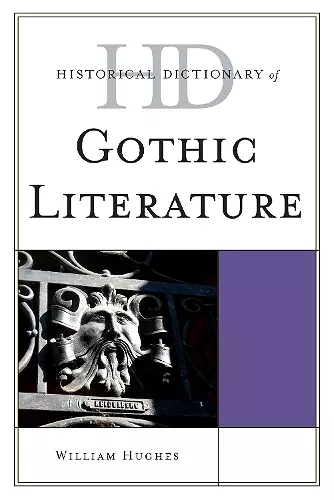Historical Dictionary of Gothic Literature
Format:Hardback
Publisher:Scarecrow Press
Published:19th Dec '12
Currently unavailable, and unfortunately no date known when it will be back

Literary fashions come and go, but some hang around longer than others, like Gothic literature which has existed ever since The Castle of Otranto in 1764. During this long while, it has spread from England, to the rest of Great Britain, and across to the continent, and off to America and Australia, filling in the gaps more recently. Most of it is in English, but hardly all, and it has adopted all styles, from romanticism, to modernism, to postmodernism and even adjusted to feminist and queer literature, and science fiction. We have all, read some Gothic tales or if not read then seen them in the cinema, since they adapt well to film treatment, and it would be hard to find anyone who has not heard of ghosts and vampires, let alone Count Dracula and Frankenstein. On the other hand, some of us are inveterate Gothic fans, reading one book or story after the other. The Historical Dictionary of Gothic Literature follows this long and winding path, first in an extensive chronology and then a useful introduction which explains the nature of Gothic and shows how it has evolved. Obviously, the dictionary section has entries on major writers, and some of the best-known works, but also on geographical variants like Irish, Scottish or Russian Gothic and Female Gothic, Queer Gothic and Science Fiction. This is provided in over 200 often substantial and always intriguing entries. More can be found in a detailed bibliography, including general works but also more specialized ones on different styles and genres, and also specific authors. This book should certainly interest the fans but also more serious researchers.
As noted in the introduction, the term gothic is culturally complex, and its meanings have varied greatly across the 400 years of its persistence in the English language. This compact volume spans the history of gothic literature from its appropriation in the mid-eighteenth century to the recent publication of the Twilight series. Hughes, professor of gothic studies at Bath Spa University, interprets the term literature liberally; among the 200 entries, Scooby-Doo and Buffy the Vampire Slayer are represented, along with The Castle of Otranto and The Turn of the Screw. The A–Z entries cover a variety of works (books, magazines, movies, and television shows are all represented) as well as central figures (Robert Bloch, Angela Olive Carter, Edgar Allan Poe) and a number of different themes and literary conventions (Doppelgánger, Ghost stories, Gothic hero, Southern gothic, Queer gothic). There is a good deal of international information here as well (Australian gothic, Irish gothic, India). Entries range from a paragraph to two pages and include a wealth of see also references in bold. Accessible enough for casual fans of the genre, the book is also suitable for more serious research, with a detailed chronology, an extremely thorough introductory essay, and a bibliography that includes critical and historical works. Recommended for academic and large public libraries. * Booklist *
“From ghoulies and ghosties and long-leggedy beasties” to “things that go bump in the night,” Hughes (gothic studies, Bath Spa Univ., UK) includes all things gothic here. More than 200 cross-referenced entries cover significant works, writers, and the popular conventions that have shaped this literary genre whose roots reach back to the 1700s. For example, you’ve heard of Anne Rice and H.P. Lovecraft, but do you know what graveyard poetry is? Both the chronology and introductory essay provide historical context for the gothic tradition, which continues to exert its influence on popular culture. The lengthy bibliography provides many avenues for further reading and research. VERDICT Don’t be afraid! Purchase for public and academic collections supporting a liberal arts curriculum. * Library Journal *
This dictionary is a good introduction to themes, authors, and terminology of Gothic literature for high school and undergraduate students. Hughes puts his extensive knowledge of this genre to good use in this broad work. The dictionary itself features a chronology, a substantial and informative introduction to the Gothic, a dictionary of terms, and a concluding bibliography. The latter is worth noting. Hughes breaks down entries for further reading by topic and Gothic author, rather than arranging entries by author's last name. This arrangement will allow users of this dictionary to find further reading on their topics very easily. As the title indicates, this dictionary focuses on literature, as opposed to the recently revised The Handbook of the Gothic, edited by Marie Mulvey-Roberts, which broadened its focus to include topics like film. Despite this, the two works have considerable crossover; many terms about the Gothic appear in both. In fact, Hughes contributed entries to the Handbook. The Historical Dictionary will be useful for libraries that lack a reference guide for the Gothic or libraries looking to update their reference collection. Summing Up: Recommended. Lower-division undergraduates and general readers. * CHOICE *
ISBN: 9780810872288
Dimensions: 235mm x 162mm x 33mm
Weight: 694g
376 pages